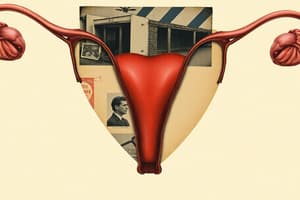Podcast
Questions and Answers
What are the CPT and ICD-10-CM codes for Case 1?
What are the CPT and ICD-10-CM codes for Case 1?
- CPT: 58300, ICD 10 CM: Z30.430
- CPT: 57460, ICD 10 CM: R87.619
- CPT: 57260, ICD 10 CM: N95.0
- CPT: 57160, ICD 10 CM: N81.3 (correct)
What are the CPT and ICD-10-CM codes for Case 2?
What are the CPT and ICD-10-CM codes for Case 2?
- CPT: 58340, 74740-26, ICD 10 CM: N97.9
- CPT: 57460, ICD 10 CM: R87.619
- CPT: 57260, 58260-51, 57283-59, ICD 10 CM: N81.3 ,N95.0, N32.89 (correct)
- CPT: 58300, ICD 10 CM: Z30.430
What are the CPT and ICD-10-CM codes for Case 3?
What are the CPT and ICD-10-CM codes for Case 3?
- CPT: 57460, ICD 10 CM: R87.619 (correct)
- CPT: 58300, ICD 10 CM: Z30.430
- CPT: 57260, 58260-51, 57283-59, ICD 10 CM: N81.3 ,N95.0, N32.89
- CPT: 57160, ICD 10 CM: N81.3
What are the CPT and ICD-10-CM codes for Case 4?
What are the CPT and ICD-10-CM codes for Case 4?
What are the CPT and ICD-10-CM codes for Case 5?
What are the CPT and ICD-10-CM codes for Case 5?
Flashcards are hidden until you start studying
Study Notes
Case 1 Overview
- Diagnosis involves Stage III cystocele and Stage II uterine prolapse; cystocele coded under uterine prolapse.
- Procedure performed: Pessary fitting for pelvic organ prolapse treatment; patient 75, gravida 4, para 4.
- Examination revealed third-degree cystocele and uterine prolapse, with improved vaginal tissue condition.
- Multiple pessary sizes tested: #4, #5, and finally #6 ring pessary chosen for comfort and effectiveness.
- Follow-up plan includes weekly pessary removal, continued Premarin cream use, and monitoring for discharge or bleeding.
- CPT code: 57160; ICD-10-CM code: N81.3.
Case 2 Overview
- Diagnoses include complete procidentia, recurrent urinary tract infections, and postmenopausal vaginal bleeding.
- Surgical procedures: Vaginal hysterectomy, anterior and posterior colporrhaphy, cystoscopy, and vaginal vault suspension performed.
- Cervical findings included hypertrophic ulceration; biopsy negative for neoplasia.
- Procedure noted use of indigo carmine for visualization; confirmed bilateral ureteral patency.
- Comprehensive surgical procedures involved detailed dissection and suturing to ensure hemostasis and support.
- CPT codes: 57260, 58260-51, 57283-59; ICD-10-CM codes: N81.3, N95.0, N32.89.
Case 3 Overview
- Patient: 21-year-old woman, three pregnancies, one live birth, presenting for follow-up after abnormal Pap test.
- Colposcopy performed; aceto-white lesions observed, and biopsy taken via LEEP for cervical examination.
- Instructions provided for postoperative care and warning signs to monitor.
- CPT code: 57460; ICD-10-CM code: R87.619.
Case 4 Overview
- Chief complaint: Contraceptive placement of IUD; patient is a 29-year-old post-delivery female seeking Skyla IUD.
- Procedure involved positioning, cervical cleaning with Betadine, tenaculum placement, and sounding of the uterus.
- IUD properly placed and strings adjusted; patient tolerated the procedure well.
- CPT code: 58300, J7301; ICD-10-CM code: Z30.430.
Case 5 Overview
- Patient: 30-year-old female, never pregnant, with irregular periods and infertility requiring hysterosalpingogram (HSG).
- Procedure included cervical visualization, anesthetic application, and introduction of HSG catheter with contrast injection.
- Findings revealed normal uterus shape; left tube filled and spilled, right tube filled without spill observable.
- Follow-up care planned as necessary.
- CPT codes: 58340, 74740-26; ICD-10-CM code: N97.9.
Studying That Suits You
Use AI to generate personalized quizzes and flashcards to suit your learning preferences.




